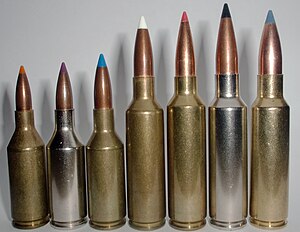
The .338 Lapua Magnum is a rimless, bottlenecked, centerfire rifle cartridge. It was developed during the 1980s as a high-powered, long-range cartridge for military snipers. Due to its use in the War in Afghanistan and the Iraq War, the cartridge has become widely available.

The .308 Winchester is a smokeless powder rimless bottlenecked rifle cartridge widely used for hunting, target shooting, police, military, and personal protection applications globally. It is similar, but not identical, to the 7.62×51mm NATO cartridge.
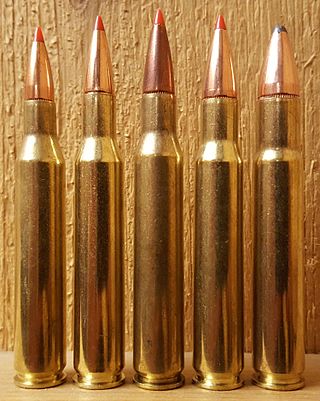
The .270 Winchester is a rifle cartridge developed by Winchester Repeating Arms Company in 1923 and it was unveiled in 1925 as a chambering for their bolt-action Model 54 to become arguably the flattest shooting cartridge of its day, only competing with the .300 Holland & Holland Magnum, also introduced in the same year.

The 7.92×57mm Mauser is a rimless bottlenecked rifle cartridge. The 7.92×57mm Mauser cartridge was adopted by the German Empire in 1903–1905, and was the German service cartridge in both World Wars. In its day, the 7.92×57mm Mauser cartridge was one of the world's most popular military cartridges. In the 21st century it is still a popular sport and hunting cartridge that is factory-produced in Europe and the United States.
The .416 Rigby is a rifle cartridge designed in 1911 by London based gunmaker John Rigby & Company, for hunting dangerous game. It is the first cartridge to use a bullet of .416 inch diameter. The rifles, as built by John Rigby & Co., were initially made up on the Magnum Mauser 98 action, although in later years, some were made on standard length actions, a perfect example being the rifle used by legendary professional hunter Harry Selby. Other famous users of the cartridge were Commander David Enderby Blunt, John Taylor, and Jack O'Connor.
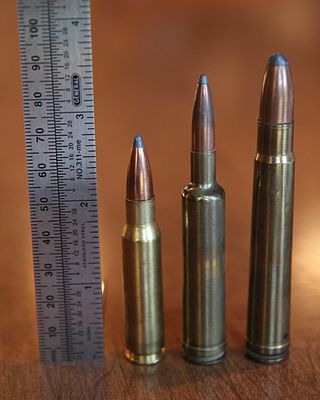
The .257 Weatherby Magnum is a .257 caliber (6.53 mm) belted bottlenecked cartridge. It is one of the original standard length magnums developed by shortening the .375 H&H Magnum case to approx. 2.5 in (64 mm). Of the cartridges developed by Roy Weatherby, the .257 Weatherby Magnum was known to have been his favorite, and the cartridge currently ranks third in Weatherby cartridge sales, after the .30-378 Weatherby Magnum and the .300 Weatherby Magnum.

The .375 H&H Magnum, also known as .375 Holland & Holland Magnum, is a medium-bore rifle cartridge introduced in 1912 by London based gunmaker Holland & Holland. The .375 H&H cartridge featured a belt to ensure the correct headspace, which otherwise might be unreliable, given the narrow shoulder of the cartridge case. The cartridge was designed to use cordite which was made in long strands – hence the tapered shape of the case, which, as a beneficial side effect also helped in smooth chambering and extraction from a rifle's breech.
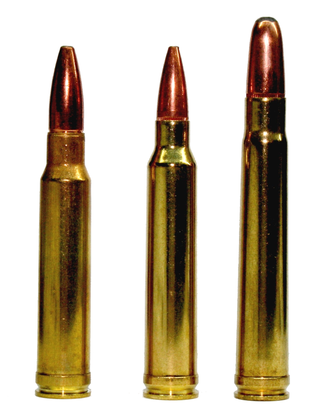
The .300 Winchester Magnum is a belted, bottlenecked magnum rifle cartridge that was introduced by the Winchester Repeating Arms Company in 1963. The .300 Winchester Magnum is a magnum cartridge designed to fit in a standard rifle action. It is based on the .375 H&H Magnum, which has been blown out, shortened, and necked down to accept a .30 caliber (7.62 mm) bullet.

The 7mm Remington Magnum rifle cartridge was introduced as a commercially available round in 1962, along with the new Remington Model 700 bolt-action rifle. It is a member of the belted magnum family that is directly derived from the venerable .375 H&H Magnum. The original purpose of the belted magnum concept taken from the .300 H&H Magnum and .375 H&H Magnum, was to provide precise headspace control, since the sloping shoulders, while easing cartridge extraction, were unsuitable for this purpose. Improved cartridge extraction reliability is desirable while hunting dangerous game, in particular when a fast follow-up shot is required. The 7mm Remington Magnum is based on the commercial .264 Winchester Magnum, .338 Winchester Magnum, and .458 Winchester Magnum, which were based on the same belted .300 H&H Magnum and .375 H&H Magnum cases, trimmed to nearly the same length as the .270 Weatherby Magnum.

The 8mm Remington Magnum belted rifle cartridge was introduced by Remington Arms Company in 1978 as a new chambering for the model 700 BDL rifle. The 8mm Remington Magnum's parent case is the .375 H&H Magnum. It is a very long and powerful cartridge that cannot be used in standard length actions, such as those that accommodate the .30-06 Springfield.

The 8×68mm S rebated rim bottlenecked centerfire rifle cartridge was developed in the 1930s by August Schüler of the August Schüler Waffenfabrik, Suhl, Germany as a magnum hunting cartridge that would just fit and function in standard-sized Mauser 98 bolt-action rifles. The bore has the same lands and grooves diameters as the German 7.92×57mm Mauser service cartridge. This is one of the early examples where a completely new rifle cartridge was developed by a gunsmith to fit a specific popular and widespread type of rifle.
The .260 Remington cartridge was introduced by Remington in 1997. Many wildcat cartridges based on the .308 Winchester case had existed for years before Remington standardized this round.
The 6.5×68mm rebated rim bottlenecked centerfire rifle cartridge and its sister cartridge the 8×68mm S were developed in the 1930s by August Schüler from the August Schüler Waffenfabrik, Suhl, Germany as magnum hunting cartridges that would just fit and function in standard-sized Mauser 98 bolt-action rifles. This is one of the early examples where a completely new rifle cartridge was developed by a gunsmith to fit a specific popular and widespread type of rifle.
The 9.3×64mm Brenneke is a rimless bottlenecked centerfire rifle cartridge designed in 1927 by German gunmaker Wilhelm Brenneke. It is suitable for hunting medium to large game animals in Africa, Asia, Europe, and North America.

The .416 Remington Magnum is a .416 caliber (10.57 mm) cartridge of belted bottlenecked design. The cartridge was intended as a dangerous game hunting cartridge and released to the public in 1989. The cartridge uses the case of the 8 mm Remington Magnum as a parent cartridge. When the cartridge was released in 1988, author Frank C. Barnes considered the .416 Remington Magnum to be the "most outstanding factory cartridge introduced in decades".
The 8×64mm S is a rimless bottlenecked centerfire cartridge developed as a military service round for the German Army who never issued it. As is customary in European cartridges the 8 denotes the 8 mm bullet caliber and the 64 denotes the 64 mm (2.52 in) case length.

The .284 Winchester is a firearm cartridge, introduced by Winchester in 1963.
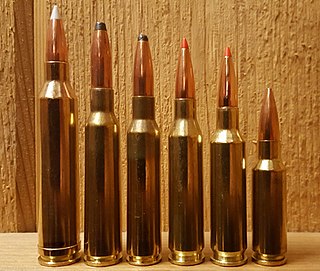
The 6.5mm Creedmoor (6.5×48mm), designated 6.5 Creedmoor by SAAMI, 6.5 Creedmoor by the C.I.P. or 6.5 CM or 6.5 CRDMR for short, is a centerfire rifle cartridge introduced by Hornady in 2007. It was developed by Hornady senior ballistics scientist Dave Emary in partnership with Dennis DeMille, the vice-president of product development at Creedmoor Sports, hence the name. The cartridge is a necked-down modification of the .30 Thompson Center.
The .450 Rigby is a rifle cartridge designed in 1994 by John Rigby & Co. for the hunting of large, thick-skinned dangerous game animals in Africa. The cartridge is based on the .416 Rigby necked up to accept a .458 in (11.6 mm) bullet and is intended for use in magazine rifles. The cartridge should not be confused with .450 Nitro Express which was introduced by Rigby in 1898, and is a rimmed cartridge intended for use in double rifles.
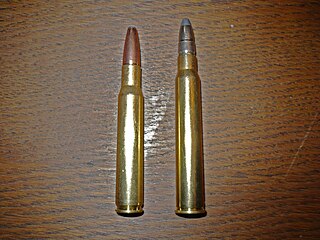
The .30 R Blaser (7.62×68mmR) is a rimmed bottlenecked centerfire cartridge developed for hunting in 1991 by Gerhard Blenk, the then owner of Blaser Jagdwaffen GmbH and Dynamit Nobel which then owned RWS ammunition.
